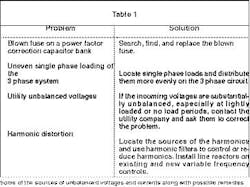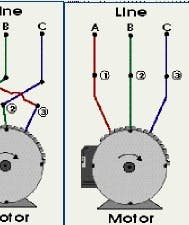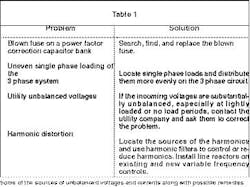History
|
View more content on PlantServices.com |
In the good old days, the only sources of unbalanced phase currents were either an unbalanced number of turns in the windings, an uneven air gap in the motor, or unbalanced phase voltages. Winding or air gap problems are definitely motor-related. On the other hand, unbalanced phase voltages are a power system problem.
A slight voltage unbalance generates a disproportionately large current unbalance. The ratio is close to 8:1. In other words, a voltage unbalance of 1 percent could unbalanced phase currents by as much as 8 percent.
Here is an unscientific way of looking at the problem. First, assume an unchanging load on a motor. Suppose the motor has a nameplate full load current rating of 10 amps. This means that at full load with balanced currents, the sum of the current in the 3 phases would be 10 + 10 + 10, or 30 amps. If the phase currents then somehow become unbalanced under that constant load, the total of the 3 current flows will always be more than the total of the balanced currents.
Possibly the current might be 10.5, 11.3, and 12.1 amps, the sum of which is 33.9 amps. Although this analysis is a rather unscientific way of looking at the issue, it accurately describes the effect. Remember, a large current flow on one leg doesn't imply that the current in the other two legs will be reduced proportionately. Unbalanced currents result in higher operating temperature, shortened motor life, and efficiency reduction.
What creates unbalanced currents?
In years past, if the motor was not the problem, the source of unbalanced currents was always unbalanced phase voltages. Detectable differences in the line-to-line voltages (A to B, B to C, and C to A) would be present. The voltage differences accounted for the unbalanced currents.
In this high-tech world of ours there are other problems that frequently are not detectable using a simple voltage test. One problem of growing concern is voltage distortion caused by harmonics in the power system currents. The harmonics originate in loads in the general area that draw nonlinear, harmonic rich currents from the power system. This distorts the normal voltage sine-wave. The distortion can cause unbalanced currents in motors even when phase voltage differences are not detectable with a voltmeter.
For example, if you suspect unbalanced motor currents and rely on measurements taken with a digital voltmeter, the phase-to-phase readings might be very close to one another. Under these circumstances, the natural tendency is to blame the motor for the problem. But, before you go off half-cocked, go a step further and identify or dismiss the motor as the source of the problem.
Motor diagnosis
The best easy test for qualifying the motor is to rotate the 3 phases. This test differentiates between the possible sources of the problem. First, record the as-is current in each power leg. Label the phases A, B, and C. Label the motor leads connected to them as 1, 2, and 3. Rotate motor lead 1 by reconnecting it to power supply lead B; reconnect motor lead 2 to power supply lead C; reconnect motor lead 3 to power supply lead A. Moving three legs keeps the motor rotating in the same direction. Once again, record the current present in each power line leg.
If the high current seems to be associated with the same power line phase--for example, B--then the problem is a power supply problem. If, however, the high current leg moves with the motor leg, then the problem is a motor problem.
How much unbalance can you tolerate?
In general, this depends on the conditions you find. If the motor is driving the load well and the highest current in the three legs is below the nameplate full load rating, then it is generally safe to operate the motor even with any unbalance.
If the current in a leg is higher than the nameplate rating but within the normal service factor (normally 1.15), then it is probably still safe to operate the motor.
Also, it is not unusual to find currents more unbalanced at no load than under load. If this is your situation, use the amperage values taken when the motor is loaded. Finally, in general, if the high current leg is less than 10 percent higher than the average of the three legs, then it is probably safe to operate the motor.
- As a working example, consider a motor with a nameplate full load amps rating of 10.0 amps and a service factor of 1.15. Assume that the individual phase currents are:
- phase current
- A 10.6 amps
- B 9.8 amps
- C 10.2 amps
- The average current
= (10.6 + 9.8 + 10.2)/3
=10.2 amps - Determine the percent difference of the highest reading as ((highest reading - average reading) x 100)/average reading. For the motor under test, this difference is:
D = ((10.6 - 10.2) x 100)/10.2
= (0.4 x 100)/10.2
= 40/10.2
= 3.9 percent
Since this percent difference is under the 10 percent limit, the motor probably is safe to operate as it is currently operating. Unbalanced currents on 3 phase motors are undesirable but you can tolerate a small amount of unbalance. Excessive unbalanced currents, on the other hand, shorten motor life and increase energy consumption.


